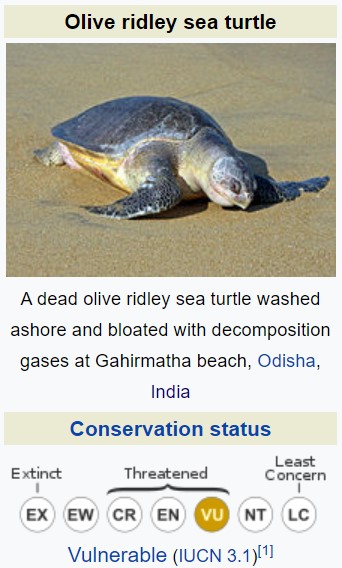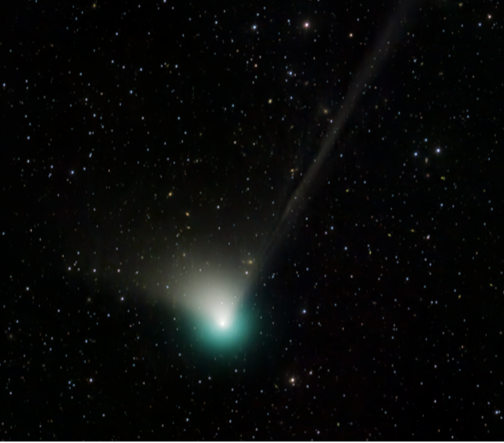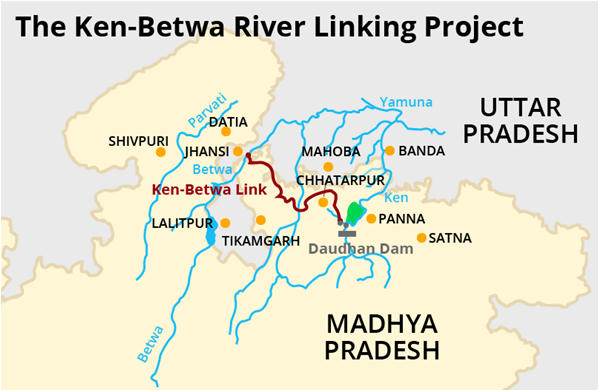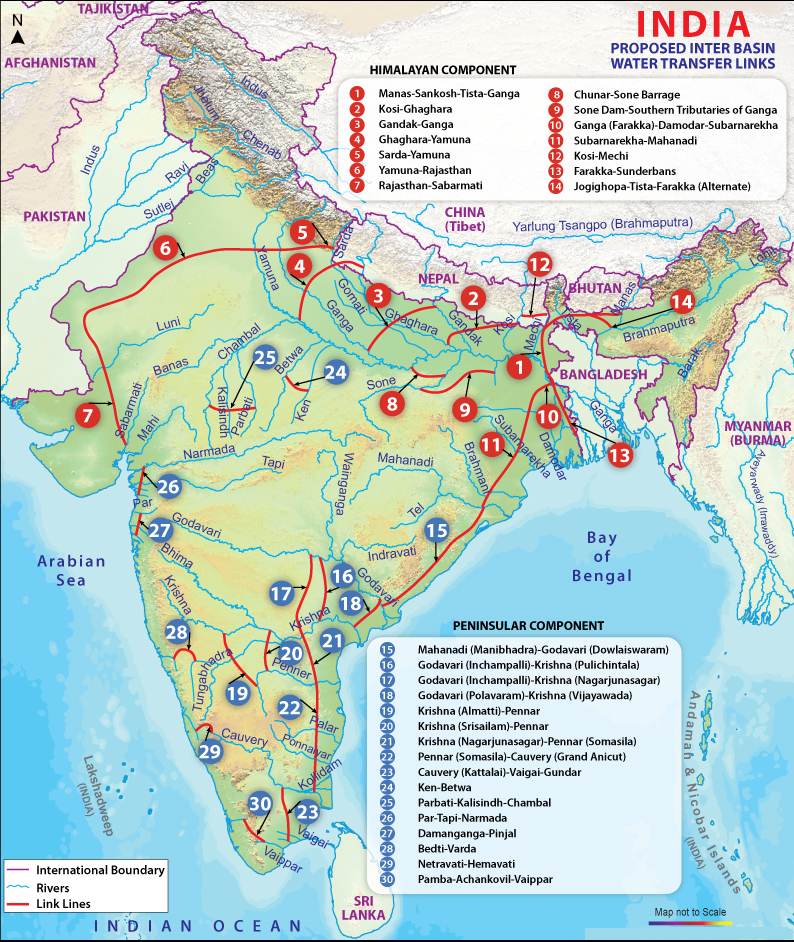CONTENT
- Olive Ridley Sea turtles
- Norovirus
- Green comet
- Ken-Betwa Link Project
- FASTag
- Trans Fat
Olive Ridley Sea Turtles
Context:
Hundreds of dead Olive Ridley turtles (Lepidochelys olivacea) have washed ashore along the coastline between Kakinada and Antarvedi in the Godavari region of Andhra Pradesh during the ongoing annual breeding season on the east coast.
Relevance:
Prelims, GS-III: Environment and Ecology
Dimensions of the Article:
- Olive Ridley Sea Turtle
- Breeding Grounds of the Olive Ridley Sea Turtle in India
- Threats to the Olive Ridley Sea Turtle
- Turtles and Turtle conservation in India
Olive Ridley Sea Turtle
- The olive ridley sea turtle (Lepidochelys olivacea), also known commonly as the Pacific ridley sea turtle, is a species of turtle in the family Cheloniidae.
- The species is the second smallest and most abundant of all sea turtles found in the world.
- This turtle and the related Kemps ridley turtle are best known for their unique mass nesting called arribada, where thousands of females come together on the same beach to lay eggs.
- The species is listed as Vulnerable in the IUCN Red List, Appendix 1 in CITES, and Schedule 1 in Wildlife Protection Act, 1972.
- Olive-ridleys face serious threats across their migratory route, habitat and nesting beaches, due to human activities such as unfriendly turtle fishing practices, development, and exploitation of nesting beaches for ports, and tourist centres.

Breeding Grounds of the Olive Ridley Sea Turtle in India
- The Gahirmatha Beach in Kendrapara district of Odisha (India), which is now a part of the Bhitarkanika Wildlife Sanctuary, is the largest breeding ground for these turtles.
- The Gahirmatha Marine Wildlife Sanctuary, which bounds the Bhitarkanika Wildlife Sanctuary to the east, was created in September 1997, and encompasses Gahirmatha Beach and an adjacent portion of the Bay of Bengal.
- Bhitarkanika mangroves were designated a Ramsar Wetland of International Importance in 2002. It is the world’s largest known rookery of olive ridley sea turtles.
- Apart from Gahirmatha rookery, two other mass nesting beaches have been located, which are on the mouth of rivers Rushikulya and Devi.
- The spectacular site of mass congregation of olive ridley sea turtles for mating and nesting enthralls both the scientists and the nature lovers throughout the world.
Threats to the Olive Ridley Sea Turtle
- Known predators of olive ridley eggs include raccoons, coyotes, feral dogs and pigs, opossums, coatimundi, caimans, ghost crabs, and the sunbeam snake.
- Hatchlings are preyed upon as they travel across the beach to the water by vultures, frigate birds, crabs, raccoons, coyotes, iguanas, and snakes. In the water, hatchling predators most likely include oceanic fishes, sharks, and crocodiles.
- Adults have relatively few known predators, other than sharks, and killer whales are responsible for occasional attacks. On land, nesting females may be attacked by jaguars. Notably, the jaguar is the only cat with a strong enough bite to penetrate a sea turtle’s shell, thought to be an evolutionary adaption from the Holocene extinction event.
- In recent years, increased predation on turtles by jaguars has been noted, perhaps due to habitat loss and fewer alternative food sources. Sea turtles are comparatively defenseless in this situation, as they cannot pull their heads into their shells like freshwater and terrestrial turtles.
- Humans are still listed as the leading threat to L. olivacea, responsible for unsustainable egg collection, slaughtering nesting females on the beach, and direct harvesting adults at sea for commercial sale of both the meat and hides.
Turtles and Turtle conservation in India
- There are five turtle species in Indian waters — Leatherback, Loggerhead, Hawksbill, Green and Olive Ridley.
- In India sea turtles are protected under the Indian Wildlife Protection Act of 1972, under the Schedule I Part II.
- Every year, thousands of sea turtles are accidentally captured, injured or killed by mechanised boats, trawl nets and gill nets operated and used by comercial fishermen.
- The turtle breeding season is usually between November and December. In Tamil Nadu, for example, the Olive Ridley nests between December and April along the Chennai-Kancheepuram coastline.
- Sea turtles, especially the leatherback, keep jellyfish under control, thereby helping to maintain healthy fish stocks in the oceans.
- The Green turtle feeds on sea grass beds and by cropping the grass provide a nursery for numerous species of fish, shellfish and crustaceans.
-Source: The Hindu
Norovirus
Context:
Recently, The Kerala Health Department confirmed two cases of the gastrointestinal infection norovirus in class 1 students in Ernakulam district.
Relevance:
GS II- Health
Dimensions of the Article:
- What is norovirus?
- What are the symptoms?
- What precautions can one take?
- Treatment
What is norovirus?
- Norovirus is a highly contagious virus that is also sometimes referred to as the ‘stomach flu’ or the ‘ winter vomiting bug’.
- It can be transmitted through contaminated food, water, and surfaces.
- The primary route is oral-faecal.
- It is similar to diarrhoea-inducing rotavirus and infects people across age groups.
- Disease outbreaks typically occur aboard cruise ships, in nursing homes, dormitories, and other closed spaces.
- According to the WHO, emerging evidence suggests that “norovirus infection is associated with intestinal inflammation, malnutrition and may cause long-term morbidity”.
- It adds that an estimated 685 million cases of norovirus are seen annually, including 200 million cases amongst children under 5
What are the symptoms?
- The initial symptoms of norovirus are vomiting and/or diarrhoea, which show up one or two days after exposure to the virus.
- Patients also feel nauseous, and suffer from abdominal pain, fever, headaches and body aches.
- In extreme cases, loss of fluids could lead to dehydration.
What precautions can one take?
- One may get infected multiple times as the virus has different strains.
- Norovirus is resistant to many disinfectants and can withstand heat up to 60°C.
- Therefore, merely steaming food or chlorinating water does not kill the virus. The virus can also survive many common hand sanitisers.
- The basic precaution is also the most obvious — repeatedly washing hands with soap after using the lavatory or changing diapers.
- It is important to wash hands carefully before eating or preparing food.
Treatment:
- The disease is self-limiting. The infection, even though it takes a lot out of the patient, normally lasts only two or three days, and most individuals who are not very young, very old, or malnourished can ride it out with sufficient rest and hydration.
- Diagnosis is done by real-time reverse transcription-polymerase chain reaction.
- No vaccines are available for the disease.
- It is important to maintain hydration in the acute phase. In extreme cases, patients have to be administered rehydration fluids intravenously.
-Source: Indian Express
Green Comet
Context:
Appearing near Earth after nearly 50,000 years, and next estimated to come close to us after as many years, it might be possible to see a recently discovered green comet in the next week.

Relevance:
GS III: Science and Technology
Dimensions of the Article:
- What is the ‘green comet’?
- When and where can the green comet be seen?
- But why is it green in colour?
What is the ‘green comet’?
- After approaching the sun in the middle of January, it is now moving away from it, along its own orbit.
- The orbit indicates it comes from the edge of our solar system, a distant reservoir of comets we call the Oort cloud.
- The Oort cloud is thought to be a big, spherical region of outer space enveloping our sun, consisting of innumerable small objects, such as comets and asteroids.
- NASA terms it “the most distant region of our solar system” and “Home of the Comets”.
- The Guardian reported that the green comet could be at a distance of 2.5 light minutes from Earth, meaning a “mere” 27 million miles.
Is the green comet rare?
- Coming under the category of long-period comets, which take more than 200 years to orbit the Sun, the green comet is not easily spotted.
- With a highly elliptical orbit, the comet will head back to the Oort cloud and make its next appearance roughly 50,000 years later.
- But given their orbits, it’s not unique for comets to reappear close to Earth only after many, many years.
When and where can the green comet be seen?
- The green comet, also known as C/2022 E3 (ZTF), can be seen in the morning sky in the Northern Hemisphere, moving towards the northwest. It will become visible in the Southern Hemisphere in early February.
- In India, it will be visible in the northwest direction, around 16° above the horizon in the Bootes constellation.
- To spot it, it is best to use telescopes, binoculars, or view it under dark skies. However, due to light pollution, it may be difficult to see with the naked eye.
But why is it green in colour?
- Comets are frozen rocky or gas-filled objects that are remnants of the formation of the solar system.
- Due to their composition, characteristics and the path they move in, they tend to leave a light “behind them”.
- Here, the comet itself is green (called the head of the comet) and emits a whitish light behind it (often called the tail of the comet).
- Just like other bodies in space, comets also have orbits. They are sometimes pulled in close to the sun because of the sun’s gravity acting on them.
- NASA explains that as they orbit near the Sun, “They heat up and spew gases and dust into a glowing head that can be larger than a planet”.
- The remains of dust following this burning up, from a distance, look like a trail of light to humans on Earth.
- Comets, therefore, have often been seen giving out blue or whiteish light, or even green.
- In this case, the green glow “is thought to arise from the presence of diatomic carbon – pairs of carbon atoms that are bound together – in the head of the comet.
- The molecule emits green light when excited by the ultraviolet rays in solar radiation,” The Guardian reported.
-Source: Indian Express
Ken-Betwa Link Project
Context:
Recently, The Third Meeting of Steering Committee of Ken-Betwa Link Project (SC-KBLP) was held at Vigyan Bhawan, New Delhi.
Relevance:
GS-I: Geography (Drainage System in India, Projects to improve Irrigation), GS-II: Polity and Governance (Inter-State Relations)
Dimensions of the Article:
- Interlinking of Rivers
- What is the Ken-Betwa Link Project?
- Which regions will benefit from the Ken-Betwa Link Project?
Interlinking of Rivers
- In 1858, Arthur Cotton (British general and irrigation Engineer) came up with even more ambitious proposals such as connecting all major rivers of India, and interlinking of canals and rivers. He suggested drought-relief measures for Odisha.
- The National River Linking Project (NRLP) formally known as the National Perspective Plan, envisages the transfer of water from water ‘surplus’ basins where there is flooding, to water ‘deficit’ basins where there is drought/scarcity, through inter-basin water transfer projects.
- The interlinking of river project is a Civil Engineering project, which aims to connect Indian rivers through reservoirs and canals.
- The farmers will not have to depend on the monsoon for cultivation and also the excess or lack of water can be overcome during flood or drought.
- Since the 1980s, the interlinking project has been managed by India’s National Water Development Agency (NWDA) under the Ministry of Water Resources.
- It has been split into three parts as follows:
- A northern Himalayan river interlink component.
- A southern peninsular component.
- An Intra-State river linking component.
As of now, six ILR projects have been under examination of the authorities:
- Ken-Betwa,
- Damanganga- Pinjal,
- Par-Tapi-Narmada,
- Manas-Sankosh-Teesta-Ganga,
- Mahanadi-Godavari and
- Godavari-Cauvery (Grand Anicut)
- With regard to the peninsular rivers, the Centre has chosen to focus on the Godavari-Cauvery link.
What is the Ken-Betwa Link Project?
- The Ken-Betwa Link Project is the first project under the National Perspective Plan for interlinking of rivers.
- KBRIL is a river-interlinking project that aims to transfer surplus water from the Ken river in Madhya Pradesh to Betwa in Uttar Pradesh to irrigate the drought-prone Bundelkhand region.
- Both Ken and Betwa are the tributaries of the Yamuna.
- The Ken-Betwa Link Canal will be 221 km long, including a 2-km long tunnel.


A Special Purpose Vehicle (SPV) for the project
- According to the statement, a Special Purpose Vehicle (SPV) called Ken-Betwa Link Project Authority (KBLPA) will be set up to implement the project.
- In fact, the Centre has set in motion the process of creation of National Interlinking of Rivers Authority (NIRA), an independent autonomous body for planning, investigation, financing and implementation of the interlinking of river (ILR) projects in the country.
- The NIRA will have powers to set up SPV for individual link projects.
Which regions will benefit from the Ken-Betwa Link Project?
- The project lies in Bundelkhand, a drought-prone region, which spreads across 13 districts of Uttar Pradesh and Madhya Pradesh.
- According to the Jal Shakti Ministry, the project will be of immense benefit to the water-starved region, especially the districts of Panna, Tikamgarh, Chhatarpur, Sagar, Damoh, Datia, Vidisha, Shivpuri and Raisen of Madhya Pradesh, and Banda, Mahoba, Jhansi and Lalitpur of Uttar Pradesh.
- “It will pave the way for more interlinking of river projects to ensure that scarcity of water do inhibitor for development in the country,” the Ministry said in a statement.
-Source: The Hindu
FASTag
Context:
Recently, NHAI said that the Total toll collection through FASTag on fee plazas, including state highway toll plazas, increased 46% to ₹50,855 crore in 2022. Total toll collection through FASTag on fee plazas, including state highway toll plazas, in 2021 was ₹34,778 crore.
Relevance:
GS III: Science and Technology
Dimensions of the Article:
- About FASTag
- About RFID Technology
About FASTag
- FASTag is an electronic toll collection system in India, operated by the National Highway Authority of India (NHAI).
- It employs Radio Frequency Identification (RFID) technology for making toll payments directly from the prepaid or savings account linked to it or directly toll owner.
- As per NHAI, FASTag has unlimited validity. 7.5% cashback offers were also provided to promote the use of FASTag.
- Dedicated Lanes at some Toll plazas have been built for FASTag.
Advantages of Using FASTag
- Digital transaction makes it easier to collect toll fees.
- Congestion in Toll plazas will reduce.
- Non-stop movement at the highways will reduce Fuel consumption and even pollution.
- The Effort in Managing toll gates is reduced as the system is more automated.
- There will also be reduced paper wastage (in the form of tokens/receipts)
- This will be a unifying system as FASTags are not specific to the state or region and work all over India.
Problems with FASTag
- Technical issues and glitches are possible which makes the system susceptible to false charges or other such issues.
- All the toll booths are yet to be made FASTag compatible and this has not necessarily reduced the congestion issue yet.
- The RFID technology is not failproof and can be misused by duplication or other “hacks”.
- The FASTags sold by banks have to be recharged from the same bank, as they are not Bank Neutral (unless you buy it directly from NHAI).
About RFID Technology
- Radio Frequency Identification (RFID) uses radio waves to communicate between two objects: a reader and a tag. RFID communication is the same as two-way radio communication in the sense that information is transmitted or received via a radio wave at a specific frequency.
- Passive tags collect energy from a nearby RFID reader’s interrogating radio waves. Active tags have a local power source such as a battery and may operate at hundreds of meters from the RFID reader.
RFID applications apart from usage in Toll collection:
- Self-checkins at Libraries / rental services as well as retail premises.
- Livestock Management and pet identification.
- Building Security – secure access controls, documentation and passports.
- Airports – for baggage tracking and tracing/locating.
- SMART home controls – systems to manage home/business energy consumption/production.
- Seismic Sensing – such as locating gas lines and temperature sensing (geophysical).
- Environmental – Energy, Ozone & Pollution measuring equipment.
-Source: The Hindu
Trans Fat
Context:
According to a recent report by the World Health Organization (WHO), five billion people globally are exposed to harmful trans fat, which is increasing their heart disease and death risk.
Relevance:
GS II: Health
Dimensions of the Article:
- About Trans fat
- Initiatives to Reduce Trans Fat Intake:
About Trans fat
- Trans fat, or trans-fatty acids, are unsaturated fatty acids that come from either natural or industrial sources.
- Naturally-occurring trans-fat comes from ruminants (cows and sheep).
- Industrially-produced trans-fat is formed in an industrial process that adds hydrogen to vegetable oil converting the liquid into a solid, resulting in “partially hydrogenated” oil (PHO).
- Partially hydrogenated oils (PHO) are solid at room temperature and prolong the shelf life of products. They are primarily used for deep frying and as an ingredient in baked goods.
- Although trans fats are edible, consuming trans fats has been shown to increase the risk of coronary artery disease in part by raising levels of low-density lipoprotein (LDL, often termed “bad cholesterol”).
Initiatives to Reduce Trans Fat Intake:
National Level:
- Foods Standards and Safety Authority of India (FSSAI) launched a “Trans Fat-Free” logo for voluntary labeling to promote TFA-free products.
Global Level:
- World Health Organisation launched a REPLACE campaign in 2018 for global-level elimination of trans-fats in industrially produced edible oils by 2023.
-Source: Down to earth





